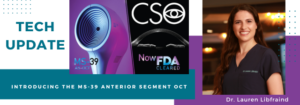Tech Update: Introducing the MS-39 Anterior Segment OCT

Exciting news from our practice – we’ve recently added a powerful new tool to our arsenal: the MS-39 anterior segment OCT from CSO. This device has recently received FDA approval, making it one of the latest diagnostic tools in ophthalmology. It combines placido disc corneal topography with spectral domain OCT based anterior segment tomography in a single instrument. We’re thrilled to share our initial experience with the MS-39 and how we’re putting it to work in our clinic.
As we know, one of the most important steps in screening candidates for refractive surgery is identifying the presence of underlying subclinical early-stage keratoconus. Traditionally, our screening relies on devices like the Pentacam for tomography and Cirrus HD-OCT or the ArcScan Insight 100 VHF digital ultrasound scanner for epithelial thickness mapping. These tools aid in diagnosing early keratoconus through patterns of epithelial thinning over anterior steepening or poster surface elevation. However, the MS-39’s simultaneous acquisition of corneal tomography and epithelial maps offers a significant advantage. With its ease of operation, higher resolution compared to swept-source Cirrus H-OCT, and faster processing than VHF digital ultrasound epithelial mapping, it enhances our ability to identify potential candidates for laser vision correction (LVC).
As seen in the figure below, the MS-39 presents a comprehensive array of data, providing detailed analysis of anterior segment anatomy. Utilizing techniques advocated by experts like Dr. Dan Reinstein, we interpret data in the “normalize” view, identifying overlaps in various parameters which may be indicative of pathology. While we continue to rely on complementary modalities like the Pentacam and ArcScan to assess for LVC candidacy, the MS-39 provides additional information which aids us in patient selection.

Beyond LVC evaluation, the MS-39 provides beautiful, detailed imaging of anterior segment anatomy, serving various purposes such as measuring corneal scars or monitoring post-operative outcomes. It also provides dynamic pupillography which enables us to measure post-operative vaults in Intraocular Collamer Lenses (ICLs) under varying light conditions.
In summary, the MS-39 has greatly enhanced our diagnostic approach, improving patient care with its comprehensive data and high-quality imaging. Its integration into our practice has been an exciting development, and we firmly believe that this new technology will greatly benefit all your patients.

